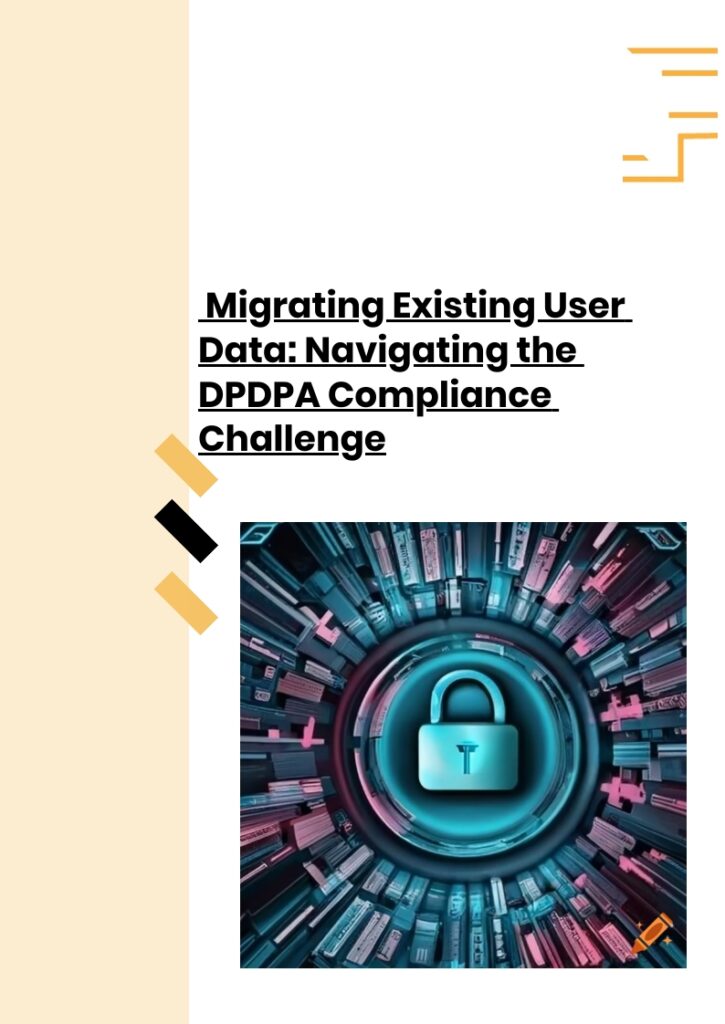
Migrating Existing User Data: Navigating the DPDPA Compliance Challenge
In the dynamic landscape of digital regulations, the Digital Personal Data Protection Act (DPDPA) stands as a crucial framework for ensuring that user data is handled with utmost care and transparency. For startups, this legislative change brings forth a significant challenge: migrating existing user data to compliant storage solutions. However, ambiguity surrounds the timeline and specific requirements for achieving full compliance, creating a pressing need for clarity.
The Urgency of Compliance: Why It Matters
Data protection regulations, such as the DPDPA, are designed to protect individuals’ privacy and data security. They mandate that companies handling personal data must implement robust data storage solutions to safeguard against breaches, misuse, and unauthorized access. For startups, compliance is not just a legal obligation but also a crucial element of building trust with users. Failing to comply can result in severe penalties, damage to reputation, and loss of customer trust.
Clarifying the Timeline for Migration
One of the most pressing concerns for startups is understanding the timeline for migrating existing user data to compliant storage solutions under the DPDPA. Unfortunately, the act does not provide a definitive timeline, leaving many businesses in a state of uncertainty. The lack of explicit deadlines makes it challenging for startups to prioritize and plan their migration efforts effectively.
In general, regulatory bodies often expect companies to act with due diligence and expedience when implementing compliance measures. While the DPDPA may not specify exact deadlines, it is prudent for startups to assume that immediate action is required. This means developing a comprehensive migration plan, setting internal deadlines, and allocating necessary resources to achieve compliance as swiftly as possible.
Strategies for a Smooth Migration
Migrating existing user data to compliant storage solutions is a complex process that involves several key steps:
1. Assessment and Audit- Conduct a thorough audit of existing data storage practices to identify non-compliant areas. This involves reviewing data collection methods, storage locations, and access controls.
2. Data Classification: Categorize data based on sensitivity and compliance requirements. Sensitive personal data may require stricter controls and more secure storage solutions.
3. Choosing Compliant Solutions: Research and select storage solutions that meet DPDPA requirements. This may involve cloud storage providers, encryption technologies, and access control mechanisms.
4. Data Migration Plan- Develop a detailed migration plan that outlines the steps, timelines, and responsible personnel for the migration process. Ensure that the plan includes testing and validation phases to verify the accuracy and security of the migrated data.
5. Data Minimization- Implement data minimization principles by retaining only the data necessary for business operations and compliance. This reduces the risk associated with storing excessive amounts of personal data.
6. User Notification-Inform users about the data migration process, especially if there are any changes to data handling practices. Transparency is crucial for maintaining user trust and complying with consent requirements.
7. Monitoring and Compliance- Establish continuous monitoring and auditing mechanisms to ensure ongoing compliance with the DPDPA. This includes regular security assessments and updates to data protection policies.
Exceptions for Startups with Historical Data
Another critical question is whether there are exceptions for startups with historical data storage practices that may not be fully compliant with the DPDPA. Startups often face unique challenges due to limited resources and evolving business models. While the DPDPA does not explicitly outline exceptions, regulatory authorities may provide some leniency for startups during the transition phase, provided that they demonstrate a genuine effort towards compliance.
Regulatory bodies may consider factors such as the size of the startup, the volume of data processed, and the potential impact on users. Startups should proactively engage with regulatory authorities to seek guidance and clarify their specific circumstances. Demonstrating a commitment to achieving compliance, even if full compliance is not immediately feasible, can be beneficial in negotiating reasonable timelines and expectations.
Potential Consequences of Non-Compliance
Non-compliance with the DPDPA during the migration process can lead to severe consequences. Startups must understand the potential risks involved to prioritize their efforts and mitigate any negative impacts. The consequences of non-compliance can include:
1. Financial Penalties- Regulatory authorities can impose significant fines on companies that fail to comply with the DPDPA. These fines can be substantial and may have a crippling effect on startups with limited financial resources.
2. Legal Action- Non-compliance can result in legal action from regulatory bodies or affected individuals. This can lead to costly litigation and further damage to the startup’s reputation.
3. Reputational Damage- Trust is a critical asset for any business. Data breaches or non-compliance incidents can erode user trust and result in negative publicity. Startups may find it challenging to regain the confidence of their users and partners.
4. Operational Disruptions-Regulatory scrutiny and enforcement actions can disrupt business operations. Startups may need to divert resources and attention away from core business activities to address compliance issues, hindering growth and innovation.
5. Loss of Competitive Advantage: Compliance with data protection regulations can be a differentiator in the marketplace. Non-compliant startups may lose their competitive edge as users increasingly prioritize privacy and data security.
Mitigating Risks During the Migration Process
To mitigate the risks associated with non-compliance during the migration process, startups should adopt a proactive and strategic approach:
1. Early Planning: Start planning for data migration and compliance as early as possible. Delaying the process increases the risk of non-compliance and potential penalties.
2. Expert Consultation- Engage with legal and data protection experts to ensure a thorough understanding of the DPDPA requirements and to develop a robust compliance strategy.
3. Resource Allocation-Allocate sufficient resources, including budget and personnel, to support the migration process. Investing in compliance measures can save significant costs in the long run by avoiding penalties and reputational damage.
4. Continuous Monitoring: Implement continuous monitoring and auditing mechanisms to identify and address compliance issues promptly. This includes regular security assessments, policy updates, and staff training.
5. User Engagement: Maintain open communication with users about data protection practices and compliance efforts. Transparency can enhance user trust and demonstrate a commitment to data privacy.
The Role of Technology in Achieving Compliance
Leveraging technology is essential for startups to achieve and maintain compliance with the DPDPA. Here are some technological solutions that can facilitate the migration process:
1. Cloud Storage Solutions-Many cloud storage providers offer compliant storage solutions with built-in security features such as encryption, access controls, and audit logs. Startups can leverage these solutions to ensure data security and compliance.
2. Data Encryption- Implementing encryption for data at rest and in transit can significantly enhance data security. Encryption ensures that even if data is intercepted or accessed without authorization, it remains unreadable and unusable.
3. Access Control Mechanisms- Implement robust access control mechanisms to restrict access to sensitive data. Role-based access controls and multi-factor authentication can help prevent unauthorized access.
4. Data Management Tools-Utilize data management tools that provide features such as data classification, data minimization, and automated compliance reporting. These tools can streamline the compliance process and reduce the risk of human error.
5. Compliance Monitoring-Invest in compliance monitoring tools that provide real-time alerts and reporting on data protection issues. These tools can help startups stay ahead of potential compliance issues and take corrective actions promptly.
Conclusion
Migrating existing user data to compliant storage solutions under the DPDPA is a complex and critical task for startups. While the lack of specific timelines creates uncertainty, startups must prioritize compliance efforts to avoid severe consequences. By adopting a strategic approach, engaging with regulatory authorities, and leveraging technology, startups can navigate the compliance challenge effectively.
Ultimately, compliance with the DPDPA is not just about avoiding penalties; it is about building a foundation of trust and security that can drive long-term success. Startups that proactively embrace data protection principles will be better positioned to thrive in a digital landscape where privacy and security are paramount.





